A power outage can be a minor inconvenience or a major event, depending on its cause, timing, and duration.
And while we may not be able to control any of those things, there are some measures we can take to minimize the disruption to our lives. One of those is to know how to cook without electricity.
Here are some no-electricity cooking techniques that will come in handy the next time the power goes out – or if you choose to live off the grid.
Use A Camp Stove Or BBQ Grill
If you have a camp stove or BBQ grill with propane, you’re in luck. These can be used indoors (in a well-ventilated area) or outdoors to cook food. Just be sure to read the instructions carefully before using them.
Related: How to Make A Cool Rocket Stove For Free
There are a few different types of camp stoves you can use if you don’t have electricity, including folding steel stoves and portable butane stoves. Be sure to explore all of your options and have one of these on hand in case you lose power!
Cooking With Candles
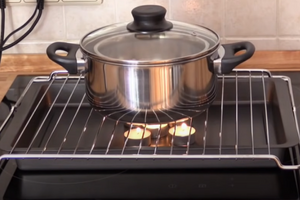 One way to cook without electricity is to use candles. Candles can provide enough heat to cook small items such as eggs or grilled cheese sandwiches.
One way to cook without electricity is to use candles. Candles can provide enough heat to cook small items such as eggs or grilled cheese sandwiches.
To cook with candles, you will need a heat-safe surface on which to place your food. A metal tray placed on top of several candles is one option.
Another option is to create a makeshift stove by stacking bricks and placing a metal grill or grate over the top. Once you have your heat-safe surface in place, light the candles and place your food on the surface.
Use A Gas Stovetop
If you have a gas stove, you can still use it to cook during a power outage—as long as there’s no gas leak. Simply light the stove with a match and adjust the knobs to control the flame.
Cook Over An Open Fire Pit
If you have a fire pit and wood available, you can cook food directly over the flames or coals. This method is best for items that can be grilled, such as hot dogs, kebabs, and hamburgers.
⇒ Learn How To Can Hamburger Meat For Long Term Preservation
Try A Solar Oven
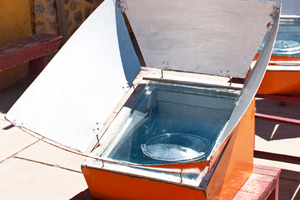 A solar oven is basically a box with clear sides that traps sunlight and uses it to heat food. These ovens can reach temperatures of up to 400 degrees Fahrenheit, so they’re great for cooking anything from casseroles to roasted chicken. Just be sure to put the solar oven in direct sunlight for best results.
A solar oven is basically a box with clear sides that traps sunlight and uses it to heat food. These ovens can reach temperatures of up to 400 degrees Fahrenheit, so they’re great for cooking anything from casseroles to roasted chicken. Just be sure to put the solar oven in direct sunlight for best results.
Make A Hobo Stove
One way to cook food in an emergency is to use a hobo stove. A hobo stove is a simple device that can be made with just a few materials.
To make a hobo stove, start by placing a can of Sterno or another fuel source in the center of a large piece of foil. Then, fold the foil up around the can to create a three-sided box. Next, poke holes in the bottom of the foil for ventilation.
Finally, place your pot or pan on top of the stove and light the fuel. The hobo stove will provide enough heat to cook food in an emergency situation.
Use A Kelly Kettle
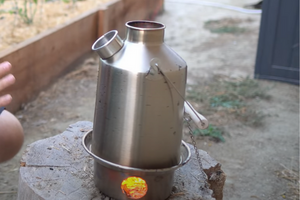 Kelly Kettles are a type of portable stove that can be used for cooking when the power is out.
Kelly Kettles are a type of portable stove that can be used for cooking when the power is out.
They are made of stainless steel and have a built-in water reservoir. To use a Kelly Kettle, fill the reservoir with water and place it over a heat source, such as a campfire or stove.
The water will boil and produce steam, which will cook the food in the kettle. Kelly Kettles are perfect for cooking noodles, rice, oatmeal, and other dry foods.
Related: 5 Instant Dry Soup Mixes Every Prepper Should Have In Their Food Storage
They can also be used to make coffee, tea, and hot chocolate. When the power is out, a Kelly Kettle can be a valuable addition to any kitchen.
Try A Volcano Stove
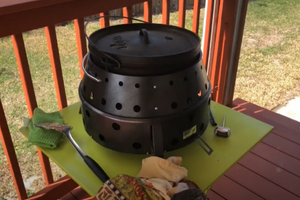 A volcano stove is a great way to cook when the power is out.
A volcano stove is a great way to cook when the power is out.
First, you will need to find a safe place to set up your stove.
Once you have found a safe location, you will need to gather some materials. You will need a can of Sterno and a small pot or pan.
Next, you will need to open the can of Sterno and light it with a match or lighter. Once the Sterno is lit, you will need to place the pot or pan on top of the can. Then, you can begin cooking your food.
Related: Dutch Oven – The Lost Art Of Scratch Cooking
Remember to keep an eye on the food so that it does not burn. When you are finished cooking, be sure to extinguish the Sterno by placing the lid back on the can. Finally, always remember to practice safety when using any type of stove.
Cook With Your Car Engine
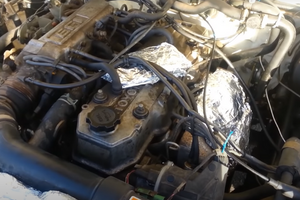 In an emergency situation, your car engine can be used as a makeshift stove.
In an emergency situation, your car engine can be used as a makeshift stove.
Here’s how to do it: first, find a level spot where you can park your car. Next, open the hood and remove the oil dipstick. Use a funnel to pour a quart of oil into the opening.
Then, take a metal can or pot and place it under the opening. Secure the can in place with something heavy, like a rock.
Finally, start your car and let it run for several minutes. The heat from the engine will cause the oil to boil, providing you with a makeshift stove that can be used to cook food.
Just be sure to keep an eye on the oil level and top it off as needed. You’ll also want to make sure you have plenty of gas for the entire process – and don’t forget to turn off your car when you’re finished cooking!
Use Your Wood Stove
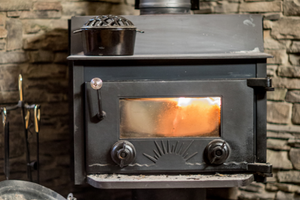 A wood stove can be a great asset during a power outage. Not only will it provide heat, but it can also be used for cooking.
A wood stove can be a great asset during a power outage. Not only will it provide heat, but it can also be used for cooking.
With a little creativity, you can use your wood stove to cook just about anything when the power is out. So next time there’s a power outage, don’t panic.
⇒ 5 Ingenious Ways To Refrigerate Your Food Without Electricity
Make A Wick Stove
A wick stove is a great way to cook when the power is out. You can make one out of a can of Sterno (denatured alcohol) or any other fuel that burns with a wick.
First, take the lid off of the can. Cut two holes in the side of the can, about an inch from the bottom. These will be for your pot handles. Next, cut a circular piece out of the bottom of the can. This will be your opening for adding fuel.
Now, cut a length of wick that will reach from the bottom of the can to just below the rim. Fold the wick over and insert it into the can through one of the holes you cut for the pot handles. Make sure that there is enough wick hanging out of the can so that you can light it when you are ready to cook.
To use your stove, simply add fuel to the can and light the wick. Place your pot on the handles and enjoy hot food even when the power is out!
Use An Earth Oven
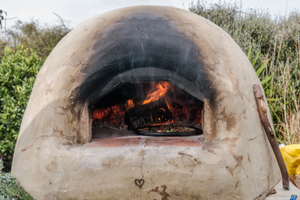 In the event of a power outage, an earth oven can be a useful tool for cooking food. Earth ovens are simple to build and can be used with wood, charcoal, or other fuel sources.
In the event of a power outage, an earth oven can be a useful tool for cooking food. Earth ovens are simple to build and can be used with wood, charcoal, or other fuel sources.
To build an earth oven, simply dig a hole in the ground and line it with rocks or bricks.
Then, build a fire in the oven and let it burn for several hours to heat the rocks. Once the rocks are hot, carefully rake out the coals and ashes. Place your food on a metal grate or screen and lower it into the oven.
Cover the oven with more hot rocks and dirt to insulate it and prevent heat from escaping. Let the food cook for several hours before checking on it. When ready, the food will be hot and steaming. Enjoy your meal!
A power outage doesn’t have to mean going without food altogether—if you know how to get creative and use some of these no-electricity cooking techniques. So next time the power goes out, don’t panic— just grab your camp stove or solar oven and get cooking!

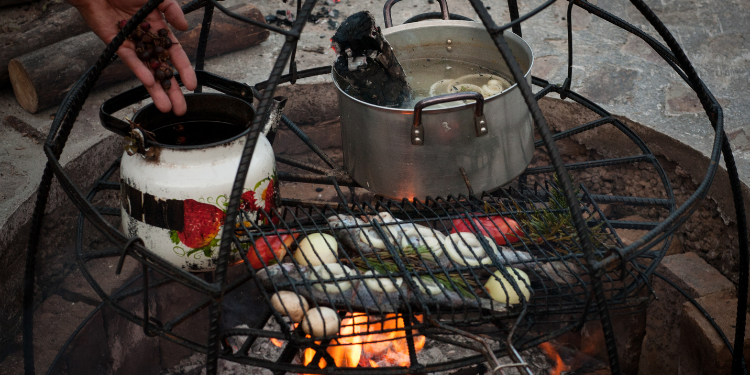













Most modern gas stoves will not operate without electricity. Between the anti-gas leaking safeties and the piezo electric ignition, they are almost as useless in a power outage as electric fed pellet stove. Bypassing the anti-leak safeties is not a clever idea when your home fills with explosive mixtures of gas.
Cooking with candles and a hobo stove is pretty weak heat wise and a real fire hazard. If the power is out for long enough to NEED such cooking, do you think the EMS and Fire Department might be unavailable (like in parts of Florida right now?) There is a reason we get badly burned homeless folks in our ER when their makeshift food stove sets their tents-tarps-shanties ablaze.
Using your car-trucks engine as a food heating system? WHY do you need to ADD a quart of oil and “Boil the oil” catching it and all that nonsense (want to add to my burns I need to treat in a disaster?). Aside from wasting valuable gasoline (Did you notice the fuel issues in Florida folks?) sounds like a nice way to damage your engine.
I’ve wrapped c-rations in foil and set them on my tracks manifold to heat them. It’s NOT hot enough to COOK food properly. Sometimes if we moved out too quickly the c-ration might burst making a real smelly mess.
A BBQ with some full fuel tanks, a camping stove with fuel, a eco-stove with burnable tree limbs all works well in a power outage. ALL need to be OUTSIDE and watched carefully as so pets, children and idiots don’t get involved.
in regard to the gas stoves not working without a 120V electric supply >> majority of the stoves in the US only have a “safety valve” for the oven portion – the range top burners will lite with a flame input >>> it wil vary per manufacturer and it’s not a bad idea to check out yours out at the next opportunity ….
That’s why I’m keeping my 1986 Caloric 36” Gas Stove with four big burners, and a huge oven. Although it has an electric ignition, but one can still light it with a match if need be. over the years, that feature or lack there of, came in handy during a number of major East Coast Black Outs! Something to think about, if you’re thinking of redoing your kitchen and replacing your old stove. I would look for another old stove, before I purchased one of the new ones. They’re super expensive, unreliable, and not worth the money.
Sounds like your gonna starve !!!
I didn’t see any mention of a rocket stove. They can be purchased and come in a lot of different styles. I have a bucket type rocket stove that is portable and can be carried to the yard or to the lake etc. There are a lot of ways to make them if you don’t want to spend much money. There are a lot of different ways to fuel them. Small branches about the size of your thumb can be used but also dry corncobs, wads of dry weeds, charcoal or even a can of Sterno (which fits perfectly in my rocket stove and is a good option if you need to use it in a sheltered area such as a back porch). One great advantage of a rocket stove is that after the fire is going good it burns most of the pollutants that regular wood fires emit and it also uses less fuel.
I agree, a rocket stove is a great option. It’s amazing what you can cook with a handful of sticks and twigs. I built one a few years ago just to see if I could and I took it camping with me and cooked on it all week. Now I wouldn’t want to have to haul mine around because it’s made out of 4” square tubing. But works great.
I keep 5 cinder blocks in my backyard (just in case) and a smashed can in the house just for this. I can always use the cinder blocks for all kinds of things, but keep 5 always available.
Cool till winter or storms
Hi Pat my name is Pat as well and I was thinking the same thing as you! Using a rocket stove is the best way it takes very little fuel to keep it going! There are a number of way to build them as well!
Another vote for a rocket stove. I’m surprised it’s not on there.
I also don’t see spirit burners on there… a very small light easy piece of kit (you can make out of a drink can, or buy one made for not a lot of $) that can run on a number of fuels you should have prepped (most volatile fuels.) The beauty of these is you aren’t relying on a sterno, instead you can fuel them on vodka, deantured alcohol, ethanol, metho etc. Combine that with a small stove surround and you can quickly cook a lot of stuff on a little liquid fuel.
I also wanted to point out that these are mostly outdoor cooking ideas. If cooking indoors please ventilate!
Not a lot of discussion on there on no-cook methods like cold soaking oats or two minute noodles…
Sandgroper, we are fortunate to live in a warm climate so the cold soaking gives us a nice meal but in a cold climate something warm is often paramount to survival. A food thermos can be really handy with oats overnight for a hot breakfast next morning.
Personally I have gas stove (lpg), wood fire, solar oven, rocket and we are going to make the pizza style oven. Power goes off quite often over summer with fires around so we got used to doing without although we now have a genset for the longe- than-a-few-hours episodes. Solar cooking is great but I do need to plan ahead since it takes time.
I need to invest in a spirit stove too.
Ginny I picked up a very nice, good quality little spirit stove off Aliexpress. I’ve used them for years camping, and with careful selection it was easy to find one there (you want something with a variable lid – a little lid you can put on that lets you control the amount of flame. Otherwise it’s 100% ON!)
And yes, you are right about the cold, I hadn’t really thought that part through. A spirit stove won’t warm your body! But if you can boil a lot of water fast and put it into a thermos for warm soaked and have something a few hours later without having to start the fire again that’s a good solution.
Instead we battle heat, and days upon days of heat (I’m rural WA, not the wine growing country!) and we need to find ways to cool our core body temp down – swim in the dam if it’s still got water, do work at night, and the good old bushman’s evaporator (a wet cloth around the neck) is generally where I head. Hard work morning and evening, rest in the middle of the day.
My volcano stove uses charcoal or wood. We used it in the summer after 2000, but it is too heavy to move all the time. It is stored and ready for use at any time. We are capable to cook multiple items at one time by stacking them.
SHTF cooking needs to be addressed by the SHTF’s seriousness and other factors >>> open cooking in your neighborhood a couple of weeks into a store shelf clearing event will get you mobbed and likely killed by a raider ….
you need to give covert cooking some serious thought and special prepping – hiding cooking odors from a starving crowd that has had their smell acuities sharpened won’t be eazy by any means ….
in regard to the article >>> preppers need to expand on the possible outages – true the electric grid is most probable – there’s very real possibilities of natural gas and LP outages & shortages – good chance your area’s power plant would continue >>> in this regard preppers should have electric heating element cooking well prepped – a double burner “hotplate” is old school but a very practical alternative …..
If smell is a issue then you live to close
Good point! If my gas stove is out of commission, I move on to electrical appliances. One can do just about everything with a slow/fast cooker, toaster oven, electric frying pan, tea kettle and coffee pot. I try to keep two of each just in case one fails. If both the gas and electric are out, then I’m using my cast iron in the fireplace. If it’s a nice day, I’m outside with the charcoal grill, gas bbq, or wood cookstove. If it’s not a nice day and all else’s has failed, there is some Sterno for ta chaffing dish and he fondue pot. After all that, I’m out of luck and it’ll be cold again!
Well, during Hurricane Fiona, the power went out.
I fashioned my own stove like this:
I placed a cookie sheet down (outside of course & on a non-flamable surface),
that was my fire pit,
then I placed one brick on each side (you could use tin cans),
and I positioned the 2nd cookie sheet over the bricks. that was my stovetop.
I built my fire on the bottom cookie sheet.
I saturated a paper towel with cooking oil and lit it, (it burned for 15 minutes, I had to pour water over it to put it out so it could have lasted longer.)
I also picked up some tiny twigs from the ground and added them, but did
not really need to, the oil saturated paper towel works just fine all on it’s own.
I boiled water and could have cooked grilled cheese, eggs, ramen noodles, or heated some precooked food.
I tucked it away under my barbecue for next time. (Yes, I have a barbecue, but no propane, so this is a last-ditch quick and easy to make outdoor stove.)
You can get a foldable grill stand that you can place over a fire to hold your cookware and save those cookie sheets for cookies.
Yes Chuck that is true, you can,,, but I didn’t have one, and the power was out, but I did have 2 old cookie sheets! And you cannot cook directly on a grill, but you can on a cookie sheet, it’s just like a cooking pan. Drop a few eggs, and watch them sizzle!
That info on the earth oven doesn’t seem right, here how I did it:
How to Build an Earthen Oven
Also:
How to build an Earthen Oven and Use it the Same Day
Sol Cook makes a good inexpensive solar cooker that I get really food results from. It’s not as hot as the type in the article, but costs about 1/4 of it. No gas, no wood, just the sun. Light weight and easy to use.
Other than needing to cook food that is going to spoil, cooking is entirely unnecessary during a short-term outage.
It’s easy enough to eat stuff that doesn’t need to be cooked.
For a long-term outage? Most of these ideas are borderline useless or dangerous.
I’m inclined to agree.
If I was in a hurricane hit area right now I’d be shutting my gas off at the mains.
I’d be very careful about open flames. I assume the US has the ‘rotten egg smell’ in their gas like Australia does? But I’d still be careful about open flames anywhere near other people who have gas pipelines.
For a day or two you can just eat cold soaked oats and dried fruit, biltong, canned beans etc.
I light 90% or higher rubbing alcohol (isopropyl) in an empty Vienna sausage can or tuna fish can when I start a chimney of charcoal. Rubbing alcohol can also be used that way to heat a cup of water or soup. If you only have 80 proof drinking alcohol, you may want to drink the alcohol. It should bring to mind better ideas about alternative cooking fuels.
During Ian our location in the Tampa Bay area was without power for 26 hours. My sterno and alcohol fuel stove worked perfectly for making eggs for breakfast and heating soup and other precooked items, used in well ventilated porch, with fire extinguisher handy. Freezers remained closed and items were still frozen after power was back.
We had pre-planned our hot and cold water needs in advance by filling Thermos bottles with ice water and a large coffee carafe with boiling water. My husband was a happy camper, he got his hot coffee, and I conserved fuel by not having to boil water several times during the day.
Our Sun Oven and Solar kettles weren’t practical due to high winds and overcast with rain. If outage had continued after storm moved through, they would have been used along with our charcoal grill.
Great ideas!
Bricks and other things can also be easily arranged to make a stove. Also, a campfire with some rocks placed to hold a kettle is one of the most basic and old-fashioned arrangements for out in the field, with no pit digging, construction, or anything else.
My grandmother cooked on a wood cook stove year round! So you can tolerate the heat or go hungry! So many of you people are spoiled with modernization but this used to be a way of life years ago! So toughen up!!!
Your grandmother had a summer kitchen
No, mine did not!
I got my solar oven after a bad storm that left me without power for a few days. It does need sunto work, true, but it can also be used as a haybox, which can be handy.
As others mentioned, I was surprised no mention made of rocket stoves.
I hadn’t heard of the term Kelly stove. There are a few versions similar to that like the can cooker, or going back about 100 years, the Conservo, which uses steam to cook things. They were designed to use one burner, and the four-shelf model allowed for eight or so different cooking utensils inside. So you could cook the meat and all the sides, and serve right from the serving dish you placed inside the Conservo.
Another cooking gizmo that was in vogue then was the fireless cooker. Like a haybox, only you’d warm up the soapstone or iron disks, warm up your one-pot meal (or not depending upon recipe), put the food in the canister with hot discs on bottom and top, and let it cook. The fireless cooker could also be used to keep cold things cold by chilling the discs.
Having the ability to cook inside is wonderful. If there’s a hurricane or Nor’easter blowing, I don’t want to have to be outside trying to light a fire. True, I don’t necessarily have to have hot food, but in my experience when it’s cold and damp, hot food is especially welcomed.
OK here goes. I know I’m going to get flack. If you have to explain these “exotic” cooking options to people at this point, then perhaps people have not been paying attention to prepping. Camp stoves….BBQ grills….wood stoves….who would have thought?
I get it! There’s a load of websites out there that seem to be prepper 101, and often this page does a good stab at basic entry level stuff.
I wish there was a preppers site 201 and 301! For more experienced or knowledgeable people to share. A lot of it has to be sifted out of the (to me, at times) rather crazy hunting or hardcore survivalists sites, and it’s not super practical to do this all the time. (How many posts about gun sights and ammo do I have to scroll through to find useful information on how to bandage a deep penetrative wound (gunshot or otherwise)? )
Yup. When I was looking at something else completely unrelated, I saw a Conservo and was curious about it, as I hadn’t heard the name before.
I had heard of hay boxes but not of fireless cookers which used the same principle.
While that may all be level 101 to you, it might be new info to someone else who now realizes Granny’s attic has those things that can still be useful.
For first aid info, I have found it best to take local classes or attend talks given by EMTs, paramedics, or guides. Some of the info is the same no matter where you are, but a lot of it can also be specific to your general region, e.g., local plants that have healing properties, how to help with altitude sickness or hypothermia.
Where I live we have a great adult ed program with all kinds of classes, everything from how to write grants to basic boating navigation, captain license course, foraging, becoming a guide, and first aid classes. The latest first aid class covers hemorrhage control among other things.
While I can find a lot of info online, there’s something to get said for being able to learn in a more hands on environment and get the muscle memory as well as the head knowledge.
I have used my solar oven enough so that in the next prolonged outage, I don’t have to think twice about how to use it.
On walks around my neighborhood or nearby trails, I look to see how many plants I can identify and what I can remember about how to use them or stay away from them.
In my garden when I need to make a support system for my pile beans, I practice my knit tying and make netting for the plants. They don’t care if the squares aren’t exact, and it helps me hone my skill while still achieving something workable with my practice runs.
I would make a jet stove. Its easy to build , easy to use. Check em out…
You’re right. It’s not the best to fire that up in the Summer. Hurricane Fran knocked out our power for 4 days in September of ’96 in the Piedmont of NC.
We have a flat top insert in our kitchen fireplace. Open the doors and windows, start the fire and cook away. Ya do whatcha gotta do.
This article seems geared towards short term situations. Since I live in the Southwest, for extended durations I will mostly rely on solar cookers and rocket stoves to boil water and cook, conserving my limited fuel supply
also, if the LP Gas is still flowing, my gas stove range top can be lit with a spark from an old long-reach lighter we used until empty to light our grill. Now I keep it in a drawer right next to the stove and works great to light a burner when the power is out, but we also have to monitor the ventilation because the exhaust fan doesn’t work without electricity.
You forgot the rocket stove.
The idea of using the car to heat the food is a decent one, but not like the description above. And heating food is different from cooking it. It’d actually a waste of resources to try to run an engine in a car to truly cook something, it’s far better to use the engine heat WHILE TRAVELING, to just WARM or HEAT foods back up by carefully placing it on the manifold. And, depending on the particular vehicle, you have to consider the stability of the item you are placing wherever you put it. Restraining it from movement is key.
65 year old McGuyver admirer.
You can get cookers/warmers to use in cigarette lighters in cars. I have 2. You would most likely have to have an already cooked meal (think freezer meal) and plug in, and wait. (or drive) I don’t think it will actually COOK uncooked food…maybe hot cereal? I’d go for that over using your engine to cook while driving?!?!?!
There are many safe ways to cook during a power outage. But the way you cook will depend on the resources you have at hand.
In a city wood will be scarce unless you break up old funiture and that might pose a risk(just what chemicals was used in building that peice of funiture or how was that wood cured? This could cause some medical problems in certain people).
At first, charcoal for grilling, natural gas, propane or butane might be available. These will eventually run out and you will be left with using wood, solar, or old fashion curing methods to prepare foods.
Gasoline is never a good option for using. Kerosene or desiel ⛽ can be used in stoves made to burn it.
But I always say in an emergency the simplest method is the best. An open wood fire is best if you have wood and if you don’t you best find a source for it. Build you a fire pit using stones around it, then make some type of stand (I use old oven racks or grates using blocks close enough for rack to sit on over the fire pit. In this way a pan can be placed over the heat and anything can be cooked). This if done correctly is very safe way to cook.
But I also am a prepper so I have a generator, electric grill, gasoline, propane, propane heater and propane stoves stored for short term use. These were relatively inexpensive because most of them were given to me because someone was throwing them away because they needed small repairs.
The other day my grandson joined the boy scouts and so we decide to go camping. Well I thought about what we needed so I went out and bought 2 sleeping bags for 36$ each, two cots for 54$ each and a small camp stove (1 burner for making coffee which without me coffee you do not want to be around me ? ). This burner though it is only a one burner is great.
Ozark Trail Single Burner Backpacking Propane Stove
(4.5)
4.5 stars out of 71 reviews
71 reviews
$24.94
We cooked hot dogs, grilled cheese, made coffee and would have been easy to cook eggs, bacon, sausage, and even heat up precooked canned good or even cook them. It was used to make coffee 3 times, cook about 12 hot dogs, 10 grill cheeses and still had propane left, not sure how much. The propane cost 4.80 a bottle. You can cook most anything on it but it is only a one burner so it would take more time to prepare a whole meal but if you have a couple then you could cook complete meals in the same amount of time you would on a two burner camp stove that cost 200-300$.
I do plan on getting a coleman stove for camping but that would be for when my whole family goes and not just us two lol ?. That is if I can not find mine ( i got one many many years ago and think it is in storage but not sure) which is mixed up in my storage somewhere ?.
This is about being prepared. It does not matter if it is being prepared for a shtf or for just the power being off for a day or two. Everyone should be prepared for being without power for a week or two at least because it has happened to me where we were without power for three weeks and there was nothing open to buy prepared food from. The stores ran out after the frist couple days but my mother had food put back as did some of the neighbors so they pooled all the food and this allowed about 20 people to survive those three weeks. We als have natural gas heaters which we used not only for heat but because the way they were built we could place a pan on top of them and cook.
I would like to add some comments on the Kelly Kettles sense I own and use one. They are a very quick way to heat enough water for tea, coffee, hot chocolate or instant soup and freeze dried meal packs. You want to boil the water in the Kelly and pour it into your tea cup or whatever. They come with their own firebox meant for small twigs, so using them on a stove is a substitution from what they are best at. Next is that although the literature shows them being used to heat things in a pan positioned above the unit, it doesn’t work for me. You have to keep it full of water or you risk damaging the unit, and then it will boil over or boil away the water before you do much cooking. I love mine and would not trade it for anything but I also have a rocket stove I built myself. It has a 6 in inner pipe, then insulation, and a 8 in stove pipe for the outer shell. Like all aspects of prepping it is good to have several options.
I’m surprised I didn’t see anyone mention a propane gas grill with side burner(s). Propane stores almost indefinitely. I have around seven 20 lbs tanks. I can do weeks of cooking and baking from one bottle.
Oops. Delay my last. Just saw it.
@FFFPatriot: you can use the 20# tanks, but NOT INSIDE!
Per the manufacturer of MrHeater Buddy propane heaters, you can ONLY use the 1# propane tanks inside. ALL other size tanks will off-gas if it gets too hot, something you do NOT want inside, but the 1# tanks do NOT off-gas.
In the photos, it appears that these options for cooking without power are done in the summer. Almost all losses of power occur in the WINTER. I am just out of a power outage due to several storm systems one after the other. My power held out for about a week of it, then went out. Granted, I was only out for about 3 days, but some are still without power 2 weeks later. The entire system had to be practically rebuilt from scratch.
When temps are in the low 20’s or lower, and it is forming sleet/ice fog/ etc. there is NO SUN. Solar stoves are impossible due to outside temps and lack of sun. So too, is the outside cooking whether with a BBQ or an oven, not possible due to the extreme cold.
I discovered in a real situation, that I am lacking in one area: heating water/cooking. To have a system that does NOT require sun, going outside in sub temperatures, and set-ups that require hours of time (candles) is needed. A cooktop that runs on propane or other fuel system is the best option. The other vey good possibility is a wood stove. I have one, but it is inoperable at this time. And, again, you must secure the fuel for whatever option you choose.
I already have a propane heater, and lanterns (the oil lamp I purchased did not work as it was VERY poorly constructed and was cock-eyed and would not stay lit). The battery lanterns are good for general light but very poor for reading…I found flashlights, hung from a pole lamp gave sufficient light without blinding me (like the battery lanterns) worked well.
I had lots of water stored using it for flushing the toilet and for filtering with my ProOne gravity filter (very like the Berkey, but with 3rd party checks and balances, that are not questionable as the Berkeys are).
So, heat, light and water were covered. Cooking was the part that I have not sufficient preps for. (Although I probably do have a couple options in my camping gear, which wasn’t readily available ).
I strongly suggest that you find and keep at least 1 alternate fuel source stove top/cooker and get lots of fuel for it. I have stored quite a lot of the 1# propane tanks which are the ONLY ones that are for indoor use. (unlike all of the larger propane options, the 1# do not off-gass when the temperature gets too hot…this from the manufacturer of the MrHeater Buddy heaters).
So now my next step is to ensure I do have alternate fuel stoves and fuel and put them where they will be available next time the power goes out (which is at least once a year here in the Willamette Valley in Oregon)
Also, a Kelly Kettle is NOT a METHOD for cooking! It is an appliance, like a crock pot or Dutch oven, something to COOK IN. It generates no heat, which is a METHOD for cooking, something that generates HEAT in order to cook things!
I would add a small propane cook plate. In have one, and along with my propane heater (MrHeater Buddy heater) can cook anything I’d cook on regular burner. The 1# propane tanks ARE ok for indoor cooking. NO other size propane tanks are safe for indoor cooking. The 1# do NOT off-pass if they get too hot, per the manufacturer of the MrHeater Buddy. They also have cook top plates that run off butane or a butane mix. I bought the propane one as I have propane stored
sorry, off-gas!